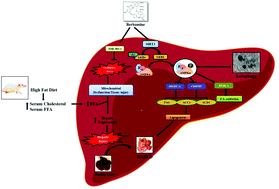Berbamine induced activation of the SIRT1/LKB1/AMPK signaling axis attenuates the development of hepatic steatosis in high-fat diet-induced NAFLD rats
Abstract
Non-alcoholic fatty liver disease (NAFLD), a chronic metabolic disorder is concomitant with oxidative stress and inflammation. This study aimed to assess the effects of berbamine (BBM), a natural bisbenzylisoquinoline alkaloid with manifold biological activities and pharmacological effects on lipid, cholesterol and glucose metabolism in a rat model of NAFLD, and to explicate the potential mechanisms underlying its activity. BBM administration alleviated the increase in the body weight and liver index of HFD rats. The aberrations in liver function, serum parameters, and microscopic changes in the liver structure of HFD fed rats were significantly improved upon BBM administration. BBM also significantly attenuated oxidative damage and inhibited triglyceride and cholesterol synthesis. The SIRT1 deacetylase activity was also enhanced by BBM through liver kinase B1 and activated AMP-activated protein kinase. Activation of the SIRT1/LKB1/AMPK pathway prevented the downstream target ACC (acetyl-CoA carboxylase) and elevation in the expression of FAS (fatty acid synthase) and SCD1 (steroyl CoA desaturase). BBM also modulated the expression of PPARs maintaining the fatty acid homeostasis regulation. The assessment of berbamine induced ultrastructural changes by TEM analysis and the expression of autophagic markers LC3a/b, Beclin 1 and p62 revealed the induction of autophagy to alleviate fatty liver conditions. These results show novel findings that BBM induced protection against hepatic lipid metabolic disorders is achieved by regulating the SIRT1/LKB1/AMPK pathway, and thus it emerges as an effective phyoconstituent for the management of NAFLD.



 Please wait while we load your content...
Please wait while we load your content...